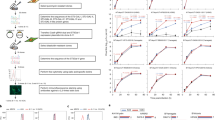Abstract
In the majority of the methods for purifying and concentrating recombinant adenoviruses (rAds) the virus that is associated with the helper cells is harvested, while the virus that is present in the cell-culture medium is discarded. During routine propagation of adenovirus type-5 vectors at optimised conditions we noted that, on average, 47% of the total amount of virus is present in the culture medium. To recover and concentrate these rAds from the medium, we devised a method, which is based on ammonium sulphate ((NH4)2SO4) precipitation. At 40% (NH4)2SO4 saturation, 95 ± 6% of the available virus precipitates from the medium, while the majority of the protein (85%) remains in solution. In contrast to adenovirus precipitation with polyethylene glycol, the (NH4)2SO4precipitation technique allows collection of precipitated rAds by filtration. We demonstrate here that (NH4)2SO4 precipitation of rAds from cell-culture medium is a simple and fast technique that can be used in combination with standard virus isolation methods to increase the yields of rAds.
This is a preview of subscription content, access via your institution
Access options
Subscribe to this journal
Receive 12 print issues and online access
$259.00 per year
only $21.58 per issue
Buy this article
- Purchase on Springer Link
- Instant access to full article PDF
Prices may be subject to local taxes which are calculated during checkout




Similar content being viewed by others
References
Winters WD, Russell WC . Studies on the assembly of adenovirus in vitro J Gen Virol 1971 10: 181–194
Lyddiatt A, O'Sullivan DA . Biochemical recovery and purification of gene therapy vectors Curr Opin Biotechnol 1998 9: 177–185
Kanegae Y, Makimura M, Saito I . A simple and efficient method for purification of infectious recombinant adenovirus Jpn J Med Sci Biol 1994 47: 157–166
Croyle MA, Anderson DJ, Roessler BJ, Amidon GL . Development of a highly efficient purification process for recombinant adenoviral vectors for oral gene delivery Pharm Dev Technol 1998 3: 365–372
Liebermann H, Mentel R . Quantification of adenovirus particles J Virol Methods 1994 50: 281–291
Shabram PW et al. Analytical anion-exchange HPLC of recombinant type-5 adenoviral particles Hum Gene Ther 1997 8: 453–465
Huyghe BG et al. Purification of a type 5 recombinant adenovirus encoding human p53 by column chromatography Hum Gene Ther 1995 6: 1403–1416
Becker TC et al. Use of recombinant adenovirus for metabolic engineering of mammalian cells Meth Cell Biol 1994 43: 161–189
Schagen FH et al. Photodynamic treatment of adenoviral vectors with visible light: an easy and convenient method for viral inactivation Gene Therapy 1999 6: 873–881
Boulanger PA, Puvion F . Large-scale preparation of soluble adenovirus hexon, penton and fiber antigens in highly purified form Eur J Biochem 1973 39: 37–42
Green AA, Hughes WL . Protein fractionation on the basis of solubility in aqueous solutions of salts and organic solvents. In: Colowick SP, Kaplan NO (eds) Methods in Enzymology Academic Press: New York 1955 67–90
Chu TH, Dornburg R . Toward highly efficient cell-type-specific gene transfer with retroviral vectors displaying single-chain antibodies J Virol 1997 71: 720–725
Stratford-Perricaudet LD, Perricaudet M . Gene transfer into animals – the promise of adenovirus. In: Cohen-Haguenauer O, Boiron M (eds) Human Gene Transfer Inserm/John Libbey Euro-Text: Paris 1991 51–61
Fallaux FJ et al. Characterization of 911: a new helper cell line for the titration and propagation of early region 1-deleted adenoviral vectors Hum Gene Ther 1996 7: 215–222
Fallaux FJ et al. New helper cells and matched early region 1-deleted adenovirus vectors prevent generation of replication-competent adenoviruses Hum Gene Ther 1998 9: 1909–1917
Becker TC et al. Use of recombinant adenovirus vectors for high-efficiency gene transfer into the Islets of Langerhans Diabetes 1993 42 (Suppl. 1): 11A
Pietersen AM et al. Specific tumor-cell killing with adenovirus vectors containing the apoptin gene Gene Therapy 1999 6: 882–892
Herz J, Gerard RD . Adenovirus-mediated transfer of low density lipoprotein receptor gene acutely accelerates cholesterol clearance in normal mice Proc Natl Acad Sci USA 1993 90: 2812–2816
Jones N, Shenk T . Isolation of deletion and substitution mutants of adenovirus type 5 Cell 1978 13: 181–188
Acknowledgements
We would like to thank Anneke Goedheer (IntroGene, Leiden) for the performance of the HPLC analysis and Steve Cramer and Diana van den Wollenberg for their excellent technical assistance. This work was financially supported by grants from the Dutch Organisation for Scientific Research (NWO), project No. 901–01–096.
Author information
Authors and Affiliations
Rights and permissions
About this article
Cite this article
Schagen, F., Rademaker, H., Rabelink, M. et al. Ammonium sulphate precipitation of recombinant adenovirus from culture medium: an easy method to increase the total virus yield. Gene Ther 7, 1570–1574 (2000). https://doi.org/10.1038/sj.gt.3301285
Received:
Accepted:
Published:
Issue Date:
DOI: https://doi.org/10.1038/sj.gt.3301285



